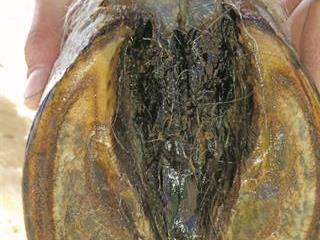
Sheared heels are asymmetrical: one heel is higher than the other. A horse with crooked legs or poor joint angles will have feet that wear unevenly and one side of the hoof will therefore have a different shape to the other. This makes the animal a prime candidate for sheared heels.
Sheared heels can also be triggered by pain higher up the leg, in the shoulder or even the wither, in the forequarter or in the hind leg. This can cause the leg to move unnaturally and result in the hoof landing badly.
Sometimes, poor trimming and shoeing (leaving the sides or heels of the foot uneven and out of balance) or neglect (bare feet growing too long), combined with one side of the long foot breaking off, will create an imbalance that can lead to sheared heels.
An unbalanced hoof puts uneven stress on the rear part of the foot, resulting in a tearing of the tissues because one heel bulb is higher than the other. If you stand the horse on a level surface and look at the legs from behind, one heel will be higher than the other.
If you stand to the side of your horse, you will notice that the coronary band of the hoof does not gradually angle towards the ground in the usual manner.
If you lift the foot, you will notice that the frog is off centre or sunken, and there might be a flare in the hoof wall on one side. Hooves that get extra stimulation will speed up their rate of growth. The hoof wall is responding to a need: the harder it strikes the ground the more hoof is required. The side receiving less impact will flare out.
Corrective trimming and shoeing to restore proper heel alignment and foot balance are required. A full bar shoe is used to increase ground surface area while protecting the affected quarter and heel. Several shoe resettings may be needed before improvement is evident. However, the prognosis is good in uncomplicated cases if the corrective measures are applied consistently until new hoof growth occurs.
Farriers
The earlier you become aware of the problem and address it, the better the outcome. Your farrier is your best friend. In an ideal world, your horses’ hooves should be trimmed or shod every four to six weeks.
Some farriers like to treat a mild case by trimming the longest heel and using a full bar shoe to stabilise the heel area and spread the weight evenly. Most cases are healed by simply removing the shoes, trimming the foot to try to help restore balance, and letting the horse go barefoot in an area where there is room for plenty of movement and natural exercise.
This will enable the foot to function more normally and redistribute the weight properly. In severe cases, where the heel bulbs are distinctly distorted, you may need several trimmings and shoeings with a full bar shoe to restore foot balance and relieve the pain.
Predisposed
It is important to realise that, even if you correct sheared heels and the heel drops back down to its proper location, the horse’s conformation has not changed. It will always be predisposed to displacing that heel again.
These horses need some type of support over their frog if they have to be shod, either with a heart bar shoe or a shoe with a plate across the heel to support it. The better you distribute the load over the frog, the better the overall health of the hoof. The key to healthy hooves is balance.








